It’s common for amphibian lovers to be curious about how tree frogs change their color. Undoubtedly it’s one of the most amazing things you can see on this beautiful earth.
Even I was curious when I first found out there were frogs that had other colors than just green. So, imagine my surprise when I found these tree frogs that came in multiple colors!
Tree frogs have special cells called chromatophores that make it easy for the frog to change their color according to their background and surroundings. Some of them turn green to brown, while some become darker, it all depends on the climate, breeding time, anxiety or stress level, etc.
The article will give you a better understanding of why tree frogs change colors. Let’s get started without further ado.
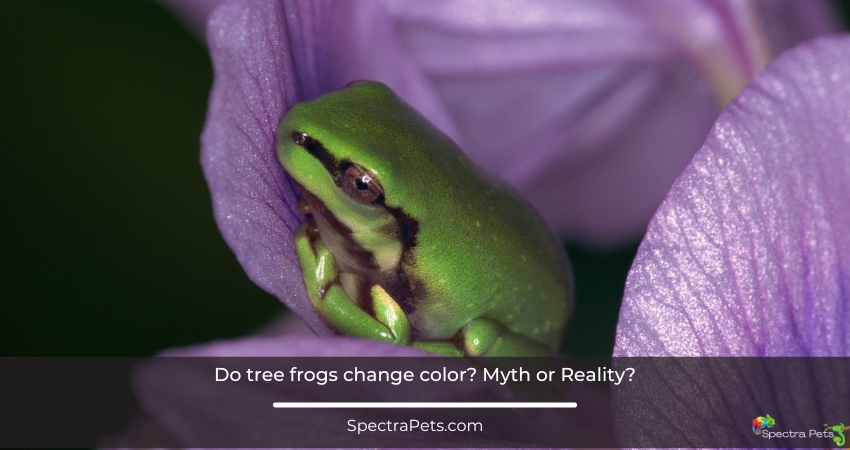
What kind of frog can change color?

When it comes to color changing the frog can be divided into 2 classifications. One is a monochromatic frog, the other is a dichromatic frog.
Monochromatic frog
A monochromatic frog can’t change their color in any condition. Even if they want to save themselves from predators, they cannot do that.
Dichromatic frog
While a dichromatic frog can change color a minimum of one time in its lifespan. Also, the color changing can be both permanent and temporary. Unlike monochromatic frogs, a dichromatic frog’s color change has much to do with its behavior, emotion, and psychology.
How Do Tree Frogs Change Color?
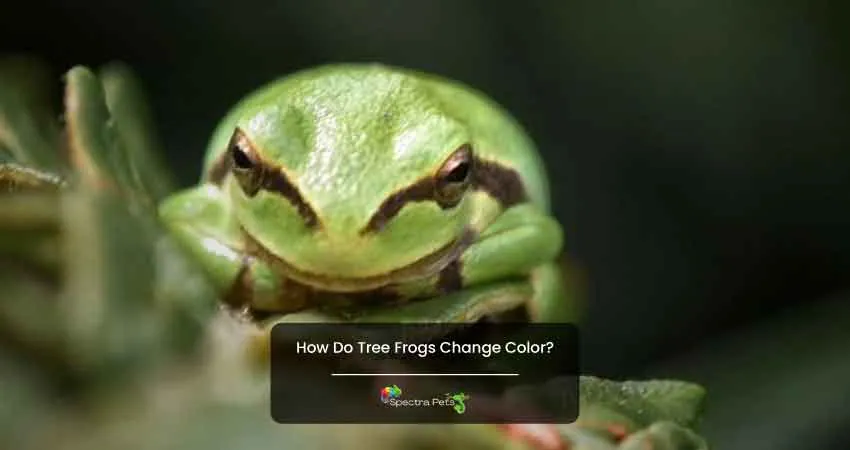
The amazing ability to change the color gives tree frogs a lot of advantages. For changing color, tree frogs use their chromatophores which is the same cell a chameleon uses to change its skin color.
This special type of cell is micro pouch-like and packed with pigment. And the pigment can include various colors like black, red, yellow and brown, etc.
Moreover, this cell has a direct connection with the muscle movement of the tree frog. These chromatophore cells can easily stretch out and also contract. Which helps them to show a higher or less numb pigment on their skin.
Whenever a tree frog finds something exciting or anxiety-related factors then its brain instantly sends a signal to its chromatophore cells and the color starts changing.
On top of that, the light-sensitive protein ensures a flawless color-turning process. Which helps immensely to match the skin color plus brightness with the same color & brightness as the surrounding.
Furthermore, chromatophores also assist the tree frog to generate such chemical compounds which help them get blended with the substrate of the forest floor or terrarium.
What colors can tree frogs be?

Tree frogs have 800 species within their family, making them one of the largest families of frogs on earth. And the most common color seen among tree frogs is gray, brown, and green.
Many tree frog species will have a mixture of these three colors.
Read More: Best Tree Frogs To Have As Pets
Why do tree frogs change their color?

A tree frog would never change its color until there’s a need for it. Multiple factors like weather, time, breeding season, and hiding from predators are the main reason they change their color.
Let’s see them in detail…
Mating
Mating is one of the critical points of tree frogs’ color changing. They do it to attract the opposite gender frogs. Only male tree frogs can change color when the breeding time appears.

However, this color variation during the mating period is much different compared to the camouflage skin color change. The main difference is the brightness of the color. During camouflage, these tiny frogs make sure their color is matching with the surrounding and background color. In such cases, the color mostly turns green, brown, and grayish.
Male tree frogs turn their skin color into an ultra-vibrant one that makes the male frog irresistible to the female tree frog. The common color during mating time is bright yellow, bright lime, bright blue, and bright green.
In the natural habitat, the most bright & colorful male tree frog gets the most access to females. Because female frogs miss no chance to mate with such beautiful male frogs.
Moreover, the transformation of skin color also gives a message to another male tree frog as a warning to leave his breeding territory and don’t dare to get close to his female partners. It also helps them to establish pure dominance in that particular area.
Temperature Regulation
Another big reason tree frogs turn their pigment into a different one is to control the overall body heat. It’s a well-known fact that dark colors have more ability to absorb light compared to light hues. And lighter colors mostly reflect any sort of light.
So changing the skin to a more light color or dark color these frogs can increase & decrease their body temperature.
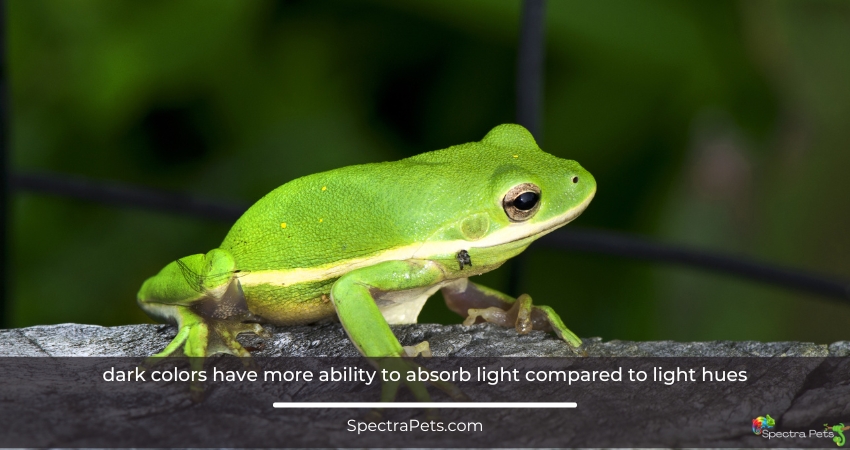
Tree frogs’ skin has uncountable pores & as the temperature of their natural habitat goes high their skin becomes merely permeable to the surrounding water. Which helps them to tune the temperature.
Moreover, the heat absorption from the sun and skin color change correlates. Excess loss of liquid makes the tree frog secrete special types of chemical compounds that turn the body into a waterproof mood. And then you get to see the change in color due to temperature shifting. Another way you can call it is thermoregulation.
So when they start changing due to thermoregulation, these tree frogs modify their skin color into 1-2 tones lighter or darker compared to their natural skin color.
Out there in the wild, most of the tree frog species turn their skin color into a lighter tone during midday and afternoon while a darker tone for night time.
Camouflage

Undoubtedly it’s one of the strongest reasons tree frogs turn their skin color into a unique one. They frequently change their color with the surrounding environment to remain out of sight of the predators which include snakes, versatile mammals, and birds of prey.
Though it helps them to avoid the predator & surely one of the best survival techniques they do in the wild. However, it only works when they stay immobile. Animals like snakes and birds can even hunt the top-notch camouflage tree frogs due to their sharp thermal sensor & vision consecutively.
Are green tree frogs poisonous? [Read More]
Showing Emotions
Every animal has emotion, and they express it in their unique way. When a tree frog feels happy, troubled, or in stress, it would show it through chaining color. Their emotion directly impacts their skin complexion. And it applies both in nature and captivity.
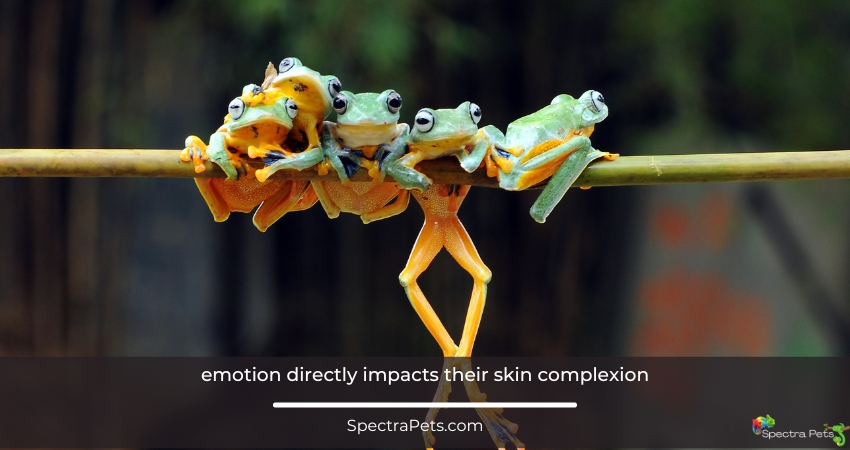
In captivity, you might notice that during feeding & handling time, the tree frogs change their color. Which indicates that your frog does not like it when you touch it. And it’s under stress at those handling moments. So unnecessary touching must be avoided for this frog.
Even tree frogs can change their color during sickness. Under your observation, if you notice that the tree frog changed without any change in eating behavior, temperature, or without any touching, that means it’s sick. In that case, you need to take your lovely frog to the vet.
Communication
The main medium for one frog to communicate with another frog is vocal communication. However, they can also use a change of color as means of communication specifically when the mating season approaches.
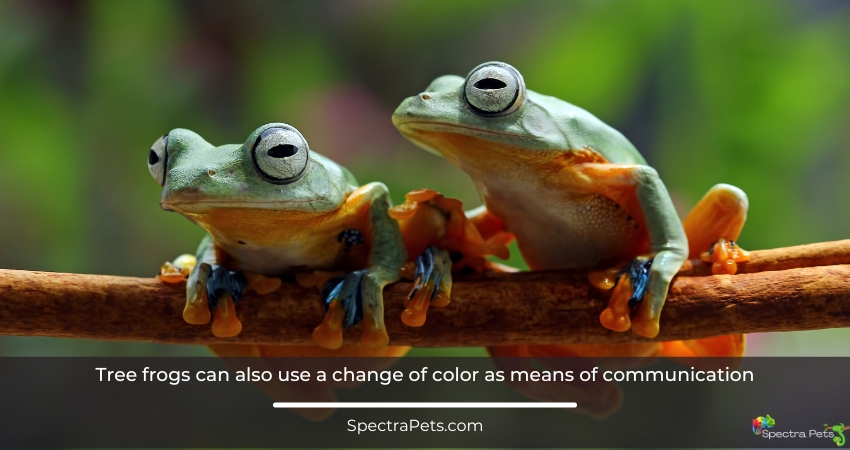
Apart from that, they give signals to other males. So that the breeding ground does not get messed up.
Moreover, if a tree frog feels threatened by a predator, it changes its color to give a signal to other frogs to do the same.
Final words
As you saw, these tiny frogs have versatile reasons for changing their skin color. And each one of them provides them benefits which can be breeding purposes or life-saving tricks or means of communication among their community.
I hope now you have a better understanding of how and why tree frogs change color.
